Even before SpaceWar!, the earliest known video game, games have always crossed paths with computers.
The earliest computers were monsters the size of suburban homes eating up enough electricity to cause brownouts in surrounding neighborhoods. The people who designed and maintained them spent long hours at the lab, often with a game of chess active on the board waiting in the break room. And when these early computer engineers got a few spare cycles on the machines, they began to experiment with ways to bring the games to the machines. Some of the earliest software were games: checkers, tic-tac-toh, Nim, simplified chess. These were not just for entertainment but for system testing and demonstration. What’s easier to grasp, a calculation of the digits of pi or a nice game of chess?
That need for demonstration was a key reason for the development of what many consider to be the most important of all games of the 1960s, a game with a long tail of influence from mainframes to the arcade to the PC. A game with fifty years of history that shows that gamers have always been the same.
SpaceWar! is Born
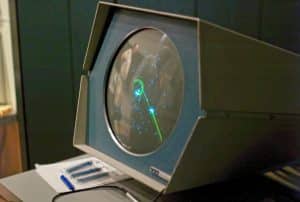
In 1962, 1962 had just taken delivery of a Digital Equipment Corporation PDP-1 computer. This was not the first computer at MIT, of course, but it was the first that a single human could operate on their own. A team was required to run the TX-0 computer, then the most advanced interactive computer on the East Coast. But a single person could flip a single switch and begin to use the PDP-1.
This personal feel was enhanced by the availability of a large, circular display screen allowing users to visualize in real time as opposed to requiring users to simply read print-outs from a console typewriter. That alone made the PDP-1 feel as accessible to an user as an iPhone today, but it still wasn’t an easy device to work with. If you wanted to create a program, you usually had to write it off-line. Then, you would use device to punch that program onto a paper tape. Then, you had to read that tape into the machine. If it wasn’t an officially-sanctioned program, you had to wait until the machine was not in use. That was typically between midnight and six in the morning.
An Early Day Start-Up
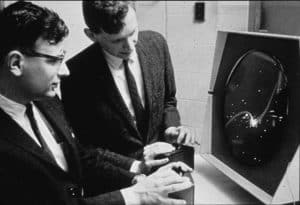
If you made an error in your code, you’d have to go back and punch an entire new tape. Or if you had a really steady hand, you could try and splice in a small section to the tape. It was no easy task to write software for the machines of the era.
One of the users of that PDP-1 was Steve Russell, nicknamed Slug (for reasons no one can seem to remember). He had been a long-time programmer, having worked on bringing the programming language LISP to massive IBM mainframes.
Looking back, Russell’s interests resemble that of a modern programmer. He was a science fiction fan, reading books by the likes of E.E. Doc Smith and Isaac Asimov. He was a gamer, frequently staying up late playing table-top games, complete with the table-chatter that usually accompanies those sorts of evenings. Perhaps more than anything else, Slug was into Toho films. Kaiju masterpieces like Godzilla and Mothra.
Throw all those things together with a love for the sweet computer sciences, and you’ve got something that very much resembles the modern tech-start-up kid right out of college, EE degree in their nervous little hands.
The Mother of Invention
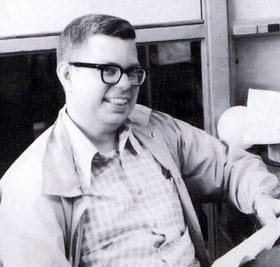
Slug was one of the primary users of the PDP-1. He developed a lot of the important software that was in use by 1962. At that time, a sense of urgency fell over the lab. There was an Open House coming. Anyone who has worked at any institution will understand the kind of terror and abstract panic that falls as an Open House looms. The new PDP-1, a $120,000 investment, needed to look like it was earning its keep.
Russell was already starting to think about what would be possible for the machine, and he quickly struck on the idea of creating a game. Since he was a major fan of space-faring science fiction, and with space exploration in the news with programs such as Project Mercury, he zeroed in on an idea of two spaceships in a galactic dogfight.
This was no easy task, as the machine had less than 4K of memory standard and ran at .187 MHz, which is about ten thousand times slower than a fairly standard PC today. Russell began to work at developing a game where two ships, one a needle-shape and the other a bit more like a triangle. These were based on the images of the ships from Buck Rogers and the real-life Redstone rocket.
The Team Assembles

These ships, typically described as the needle and the wedge, would fly through space firing space torpedoes at one another. Initially, the form of the game was pretty simple, but it still would have been a sensation. Of course, it wasn’t left to be just that. You see, Russell wasn’t alone with the machine, and various others began to think of ways to improve the program.
Russell had been working on the program with Wayne Wittanen and Martin “Shag” Graetz from the beginning. But Peter Samson, an MIT student and member of the legendary MIT Model Railroad Club, made one of the most interesting contributions.
Samson developed a program he called Expensive Planetarium. The program would display an accurate star-pattern on the screen and could be changed to display accurate patterns from different locations. Samson’s program was combined with the basic game play, and it started to seriously test the capabilities of the machine, but as is always the case, if it wasn’t over-taxing the machine, it couldn’t be allowed to stay that simple.
Reflexes or Strategy
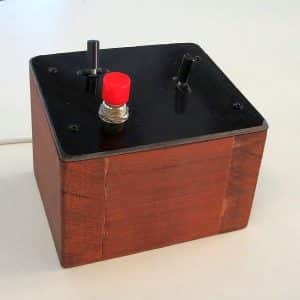
Dan Edwards and Shag Graetz saw that the game as it stood was more about fast reflexes than strategy, They began to develop a couple of new elements to improve gameplay. The idea of hyper-space had been a standard tool of science fiction for ages, and adding it into the game gave a player the chance to disappear from view briefly, and then pop back onto the screen in a random location. Initially, they only gave players the chance to jump three times, but later added an idea where a player could jump more often, each time risking explosion.
To play SpaceWar!, you had to flip the switches on the front panel of the PDP-1. That was cramped, the panel being just about 18 inches across, and it was certainly possible for a player to “accidentally” flip the wrong switch and turn off the entire machine. Programmers Alan Kotok and Bob Saunders developed a way to control the game separate from the machine itself, a pair of boxes with buttons and toggles that were wired to the machine. These were the first game-specific controllers.
With that addition, SpaceWar! was ready for the Open House.
And the Crowd Goes…
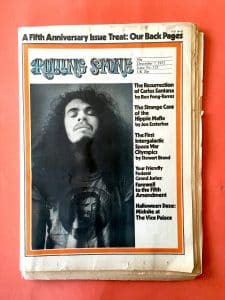
It was a massive success.
The game was action-packed, and from the get-go, there was trash-talking. Russell himself is a legendary game-talker, one of the best with his witty and precise takes on player actions. Players loved the game at the Open House, including Fred Pohl, science fiction writer and editor, who called it a “lovely game.”
The game itself didn’t die with that Open House.
The team that created it began to spread. Several ended up at Digital Equipment Corporation, and others at universities like Stanford and Carnegie-Mellon. The Digital user group, DECUS, helped to spread SpaceWar! around the world, including it as a part of their software library. Not only was the gameplay successful, but the code was highly respected, as academic and professional papers on the program were written for several conferences. Several DEC computers came with the game already pre-loaded.
Integration into Pop Culture
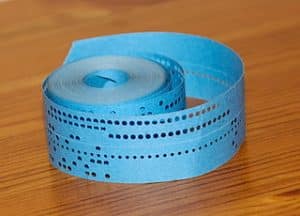
DEC’s computers were incredibly popular, especially with universities, and no one loves a good game as much as a university student. It was so popular that many schools banned the game, and as is true today, that only made sure that folks found undercover ways of playing the game on school time.
It was through the distribution of the SpaceWar! paper tape that many important figures in the history of gaming first experienced what was possible to do with a computer in gaming.
The game was so popular on college campuses that it was covered in Rolling Stone magazine. The game gained a major boost in popularity beyond the college campus because of the article. For the article, Rolling Stone hosted an event at Stanford’s Artificial Intelligence Lab, or SAIL, where an elimination tournament was held. This was the first formal computer game tournament.
Space War Goes Multi-Platform
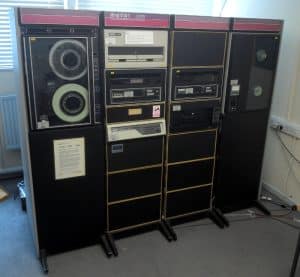
Arguably the first coin-operated video game was developed by two Stanford students – Hugh Tuck and Bill Pitts. They loved SpaceWar! and developed a version for the PDP-11, a machine much more powerful than the PDP-1, and much cheaper. After Pitts’ graduation, he developed SpaceWar! for the PDP-11, packaged it in a pair of cabinets, allowing for up to four players. They called it the Galaxy Game, and released it at Stanford’s Tresidder student union in 1971.
It stayed there until the late 1990s.
Another important version of the game was released by Nutting Associates at nearly the same time. Nolan Bushnell, an engineer and entrepreneur, had played SpaceWar! at the University of Utah in the 1960s, and had always wanted to come up with a way to bring games to amusement settings. He teamed with engineer Ted Dabney to create a version of SpaceWar! for use in an arcade setting.
They developed the game Computer Space, a somewhat simplified version of SpaceWar! It was housed in a gorgeous Space Age cabinet. The game also allowed for a single-player mode, something no other version of the game had allowed. Sadly, Computer Space was not overly successful. Partly because it was difficult to play. Partly because the video game arcade had yet to explode on to the scene. It would take another game to lead to that break-through: Pong, designed by Atari, which was founded in 1972 by Bushnell and Dabney.
SpaceWar! After Pong
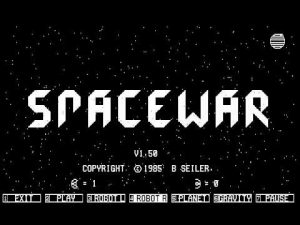
After the Ping epoch, SpaceWar! became commercialized several times under several names. These included Star Trek (1972), Space War (1977), Space Wars (1977), and Orbit (1978). SpaceWar! was a major influence on Atari’s Asteroids. In addition, when emulation of classic games became possible, SpaceWar! was a popular game for enthusiasts. It was complex enough to be a challenge but simple enough to allow for it to be created for many different kinds of systems.
Since it was never patented or copyrighted, it’s been available on dozens of different platforms. It’s still thrilling people, especially those lucky few who can play it on the original hardware at locations like the Computer History Museum and Living Computer Museum, or at events like the Vintage Computer Festival. Multiple versions of the game have been developed, often with help from the original game’s primary designer, Steve Russell.
Still Playing
Slug has remained active, interacting with programmers, giving interviews, and continuing to play SpaceWar! on a surviving, operational PDP-1, currently on display at the Computer History Museum, where Russell and Peter Samson both volunteered starting in the 1990s. He’s still the best player of the game, often winning matches against pro gamers who spent weeks training to talk on Russell.
Many viewed Russell as having an unfair advantage – he was playing against them on the PDP-1, a system Slug has been playing on since the 1960s. He continues his chatter, full of gentle mocking and sage advice, and everyone who loses to him, from three year olds playing the game for the first time to Nolan Bushnell and Bill Pitts, say that it’s a wonderful time.
SpaceWar! is one of the most significant games that led to the development of the modern video game industry. Many groups have recognized SpaceWar! as one of the foundational games, including the Library of Congress, which has been working to preserve the legacy of SpaceWar! to ensure that future generations will get to enjoy the game.
